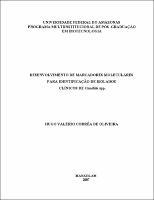| ???jsp.display-item.social.title??? |


|
Please use this identifier to cite or link to this item:
https://tede.ufam.edu.br/handle/tede/2237Full metadata record
| DC Field | Value | Language |
|---|---|---|
| dc.creator | Oliveira, Hugo Valério Corrêa de | - |
| dc.creator.Lattes | http://lattes.cnpq.br/6595179051283009 | por |
| dc.contributor.advisor1 | Martins, Adriana Sotero | - |
| dc.contributor.advisor1Lattes | http://lattes.cnpq.br/1919855068500230 | por |
| dc.date.available | 2015-04-08 | - |
| dc.date.issued | 2007-08-09 | - |
| dc.identifier.citation | OLIVEIRA, Hugo Valério Corrêa de. Desenvolvimento de marcadores moleculares para identificação de Isolados Clínicos de Candida spp.. 2007. 112 f. Dissertação (Mestrado em Biotecnologia) - Universidade Federal do Amazonas, Manaus, 2007. | por |
| dc.identifier.uri | http://tede.ufam.edu.br/handle/tede/2237 | - |
| dc.description.resumo | A candidíase vulvovaginal (CVV) é uma das mais freqüentes infecções vaginais. As leveduras do gênero Candida são os agentes etiológicos desta infecção, sendo Candida albicans a responsável majoritária. Contudo, tem -se verificado um aumento na incidência de infecções causadas por outras espécies (C. glabrata, C. tropicalis, C. parapsilosis e C. krusei). Com intuito de apresentar um viés para o processo de identificação das cinco espécies de Candida, comumente isoladas da vulv a e vagina, foi feita a análise de marcadores moleculares espécie-específicos para a região ITS1-5.8S-ITS2, do rDNA. A análise das seqüências nucleotídicas dessa região apresentou-se bastante conservada para as cepas de uma mesma espécie e, paralelamente, divergente entre as espécies do gênero. Os marcadores se traduziram em segmentos nucleotídicos, dos quais foi possível dese nvolver oligonucleotídeos espécie-específicos tecnicamente apropiados, além de sítios enzimáticos inter e intraespecíficos capazes de identificar/diferenciar as espécies de Candida. Uma análise paralela do fingerprint , gerado por simples PCR, constatou a inadequabilidade do uso dos oligonucleotídeos universais ITS1, ITS2, ITS3 e ITS4 para a identificação dessas espécies. De forma contrária, os oligonucleotídeos espécie -específicos desenvolvidos apresentaram-se eficientes corroborando, na prática, com a hipótese apresentada neste trabalho . Enzimas de restrição selecionadas para a diferenciação das espécies de Candida constituem uma alternativa a ser explorada futuramente, em experimentos de PCR -RFLP. | por |
| dc.description.abstract | The vulvovaginal candidiasis (VVC) it is one of the most frequent vaginal infections. The yeasts of the genus Candida are the etiologic agents of this infection, being Candida albicans the majority responsible. However, an increase has been verifying in the incidence of infections caused by other species ( C. glabrata, C. tropicalis, C. parapsilosis and C. krusei). With intention of presenting an inclination for the process of identification of Candida's five species, commonly isolated of the vulva and vagina, it was made the analysis of species - specific molecular markers for the region ITS1 -5.8S-ITS2, of the rDNA. The analysis of the nucleotides sequences of that region came quite conserved for the strains of a same species and, parallel, divergent among the species of the genus. The markers were translated in nucleotides segments, of the whic h it was possible to develop species -specific oligonucleotides technically proper, besides ranches enzymatic inter and intra -specific capable of to identify/differentiate Candida's species. A parallel analysis of the " fingerprint ", generated by simple PCR, it verified the inadequability of the use of the universal oligonucleotídeos ITS1, ITS2, ITS3 and ITS4 for the identification of those species. In a contrary way, the developed species -specific oligonucleotides came efficient corroborating, in practice, with the hypothesis presented in this work. Restriction enzymes selected for the differentiation of Candida's species they constitute an alternative to be explored hereafter, in experiments of PCR-RFLP. | eng |
| dc.description.sponsorship | Coordenação de Aperfeiçoamento de Pessoal de Nível Superior | - |
| dc.format | application/pdf | por |
| dc.thumbnail.url | http://200.129.163.131:8080//retrieve/6981/Disserta%c3%a7%c3%a3o%20-%20Hugo%20Val%c3%a9rio%20Corr%c3%aaa.pdf.jpg | * |
| dc.language | por | por |
| dc.publisher | Universidade Federal do Amazonas | por |
| dc.publisher.department | Instituto de Ciências Biológicas | por |
| dc.publisher.country | BR | por |
| dc.publisher.initials | UFAM | por |
| dc.publisher.program | Programa de Pós-Graduação em Biotecnologia | por |
| dc.rights | Acesso Aberto | por |
| dc.subject | Candida spp | por |
| dc.subject | Marcadores moleculares | por |
| dc.subject | Identificação molecular | por |
| dc.subject | Molecular identification | eng |
| dc.subject.cnpq | CIÊNCIAS BIOLÓGICAS | por |
| dc.title | Desenvolvimento de marcadores moleculares para identificação de Isolados Clínicos de Candida spp. | por |
| dc.type | Dissertação | por |
| Appears in Collections: | Mestrado em Biotecnologia | |
Files in This Item:
| File | Description | Size | Format | |
|---|---|---|---|---|
| Dissertação - Hugo Valério Corrêa.pdf | 1.94 MB | Adobe PDF |  Download/Open Preview |
Items in DSpace are protected by copyright, with all rights reserved, unless otherwise indicated.




